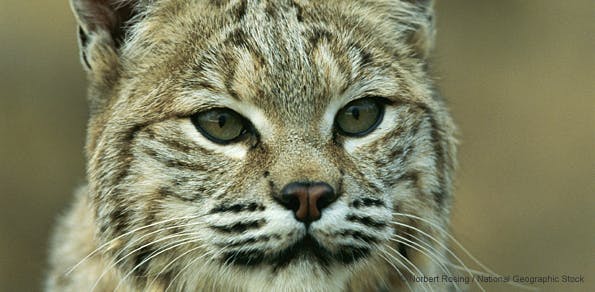Coast to Coast” is a summer blog series highlighting some of America’s most imperiled wildlife. By using the U.S. Fish and Wildlife Service’s new state-by-state endangered species map, we will tell stories about native plants and animals in unique landscapes where Defenders will be focusing its conservation efforts in coming years.
Imagine that you’re trudging through the heavy Colorado snow, hiking close to 10,000 feet. You suddenly spot what appears to be an overgrown house cat. You stop in your tracks, careful not to make a sound, peer closer and see it’s a Canada lynx. The lean grey form bounds through the snow on long legs after a snowshoe hare, the lynx’s favorite food. Its large paws keep the cat from sinking into the snow, while it listens with tufted ears to track the hare’s path.
A scene like this may be relatively common throughout Canada or Alaska, but it’s a rarity in the southern Rockies where life has been pretty rough for this mid-sized carnivore. Originally pursued by fur trappers, these critters nearly vanished from the southernmost portion of their range by the 1970s. However, in 2000 lynx were listed as threatened under the Endangered Species Act, and as a result lynx populations have started to recover. After a successful reintroduction program in Colorado (more on that later), an estimated 1,000 lynx are now spread across the U.S. from Washington to Colorado. But the Canada lynx is still threatened by habitat loss and other human activities including logging, collisions with vehicles, and trapping.
This species is famous in biology classes for its population cycles. If the snowshoe hare population goes up, a few years later the lynx population follows. Then more lynx eat more snowshoe hares, depleting the population and leaving less food for future generations. Thus the cat’s population goes down, and the cycle repeats itself. This cycle goes back and forth for each generation and keeps the populations in check. Unfortunately, for the last century or more, man has had his thumb on the scale, making it harder for lynx to rebound.
The cat’s population is spread thin, putting an already imperiled species at great risk. The lynx need higher elevation forests, filled with spruce, fir, or lodgepole pine, to survive. Unfortunately these forests are often depleted by excessive logging, mining, energy exploration, and even backcountry recreation. Lynx are relatively reclusive animals, so even the occasional thrill-seeking heli-skiier or seasonal mountain chalet may be enough to scare lynx away from vital habitat they might otherwise use for hunting, denning or finding a mate. And as the forest diminishes, so do the snowshoe hares, leaving lynx with little to eat. The U.S. Fish and Wildlife Service explains the threats the lynx is facing in this podcast:
Audio clip: Adobe Flash Player (version 9 or above) is required to play this audio clip. Download the latest version here. You also need to have JavaScript enabled in your browser.
Thankfully, there have been some positive steps forward for the lynx in the past few years. In 1999 an initiative was launched to reintroduce the cat to Colorado. While this population followed the species’ typical ups and downs, overall it has been a huge success. In the past decade, more than 200 animals were released and 103 kittens were born. In 2009, the Forest Service added an amendment to eight regional management plans to soften human impacts of logging and other resource extraction and recreation on lynx.
While these are certainly steps in the right direction, sadly, this cold-loving critter could face more serious challenges as a result of climate change. The changing climate affects the type of snow that falls in its habitat, which could allow other predators to reduce snowshoe hare populations. Jeff Corwin explains in this video how climate change hurts these elusive cats:
For decades, Defenders of Wildlife has pushed for federal actions on key predators like the Canada lynx. Defenders recognizes that by preserving habitat and securing connectivity between vital areas, sparse populations will have more room to roam and a better shot at maintaining a healthy gene pool. The next step for lynx recovery is to secure a nationwide recovery plan that will allow these important predators to make a strong comeback in more places.
But we can only do so much. The American public barely knows about the Canada lynx or the trouble it’s in. That’s why raising awareness for this rare carnivore is a top priority–the more people that know about this cool cat, the brighter its future will be!



